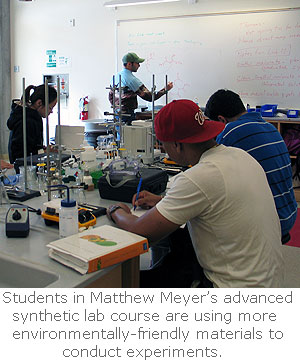

Students in professor
Matthew Meyer’sChemistry 101 lab class are seeing green.
Undergraduatestudents taking Meyer’s advanced synthetic laboratory course have conducted lab experiments using materials that are less toxic and more environmentally friendly than what has traditionally been used.
Welcome to the era of
green chemistry.
In recent years, society has become more mindful about the impact contaminants have on the environment and people are increasingly seeking ways to mitigate those toxins.
Most chemistry over the last 50 years has used heavy metals as catalysts to generate chemical reactions, said Meyer, an associate professor in the
School of Natural Sciences.
The problem is the significant environmental impact that metals can have – not only on soil and water quality, but on human health, animal and plant life. In recent years, as environmental awareness has increased, more chemists are seeking ways to use less harmful materials in their experiments and research.
Meyer said this approach to chemistry started gaining significant attention, particularly with regard to undergraduate chemical education, about five years ago. In the advanced synthetic lab class, students this semester conducted an experiment in which they used crustacean exoskeletons and agricultural byproducts as catalysts to produce chemical reactions.
The process of using small organic molecules to accelerate chemical reactions, called organocatalysis, is a rapidly growing area of
organic chemistry. Advantages of using organic catalysts, or organocatalysts, is their lack of sensitivity to moisture and oxygen, their ready availability, low cost and low toxicity. Their use, however, can pose a challenge.
When you’re working with materials outside of the traditional paradigm, it’s harder to predict (experiment) results, he said.
Meyer’s own research lab is examining the fundamental way in which organic catalysts work to make chemical reactions faster. That research is of particular benefit to pharmaceutical companies looking to create new drug therapies that could be used to treat autoimmune diseases and cancers.
Introducing other methodologies to students can have a future impact on policy, Meyer added. Not everyone in this class will become chemists, he said. Some will be policy makers. And having been exposed to these newer concepts can help make them more informed and think of the future implications in the modern world.
Seniorchemistry major Marvin Duong, a self-described environmentalist, is glad to see efforts to use less hazardous materials in the field.
It’s about how you use it instead of what you use, said Duong, who hails from Modesto.
Meyer’s
research, along with the undergraduate students working and learning in the lab class, is another example of UC Merced’s commitment to good environmental stewardship while simultaneously seeking out new solutions to solve complex problems.






